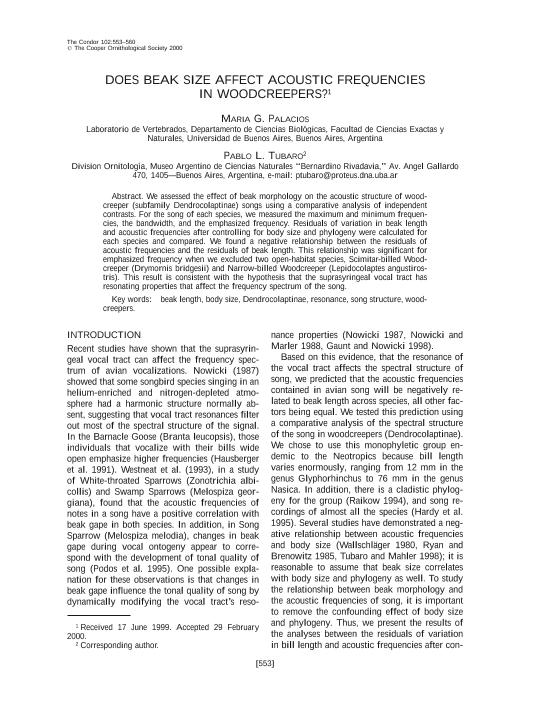Artículo
Does beak size affect acoustic frequencies in woodcreepers?
Fecha de publicación:
2000
Editorial:
Cooper Ornithological Society
Revista:
The Condor
ISSN:
0010-5422
e-ISSN:
1938-5129
Idioma:
Inglés
Tipo de recurso:
Artículo publicado
Clasificación temática:
Resumen
We assessed the effect of beak morphology on the acoustic structure of woodcreeper (subfamily Dendrocolaptinae) songs using a comparative analysis of independent contrasts. For the song of each species, we measured the maximum and minimum frequencies, the bandwidth, and the emphasized frequency. Residuals of variationin beak length and acoustic frequencies after controlling for body size and phylogeny were calculated for each species and compared. We found a negative relationship between the residuals of acoustic frequencies and the residuals of beak length. This relationship was significant for emphasized frequency when we excluded two open-habitat species, Scimitar-billed Woodcreeper (Drymornis bridgesii) and Narrow-billed Woodcreeper (Lepidocolaptes angustirostris).This result is consistent with the hypothesis that the suprasyringeal vocal tract has resonating properties that affect the frequency spectrum of the song.
Palabras clave:
Beak Length
,
Body Size
,
Dendrocolaptinae
,
Resonance
,
Song Structure
,
Woodcreepers
Archivos asociados
Licencia
Identificadores
Colecciones
Articulos(IBYME)
Articulos de INST.DE BIOLOGIA Y MEDICINA EXPERIMENTAL (I)
Articulos de INST.DE BIOLOGIA Y MEDICINA EXPERIMENTAL (I)
Articulos(MACNBR)
Articulos de MUSEO ARG.DE CS.NAT "BERNARDINO RIVADAVIA"
Articulos de MUSEO ARG.DE CS.NAT "BERNARDINO RIVADAVIA"
Citación
Palacios, María Gabriela; Tubaro, Pablo Luis; Does beak size affect acoustic frequencies in woodcreepers?; Cooper Ornithological Society; The Condor; 102; 3; 2000; 553-560
Compartir
Altmétricas




